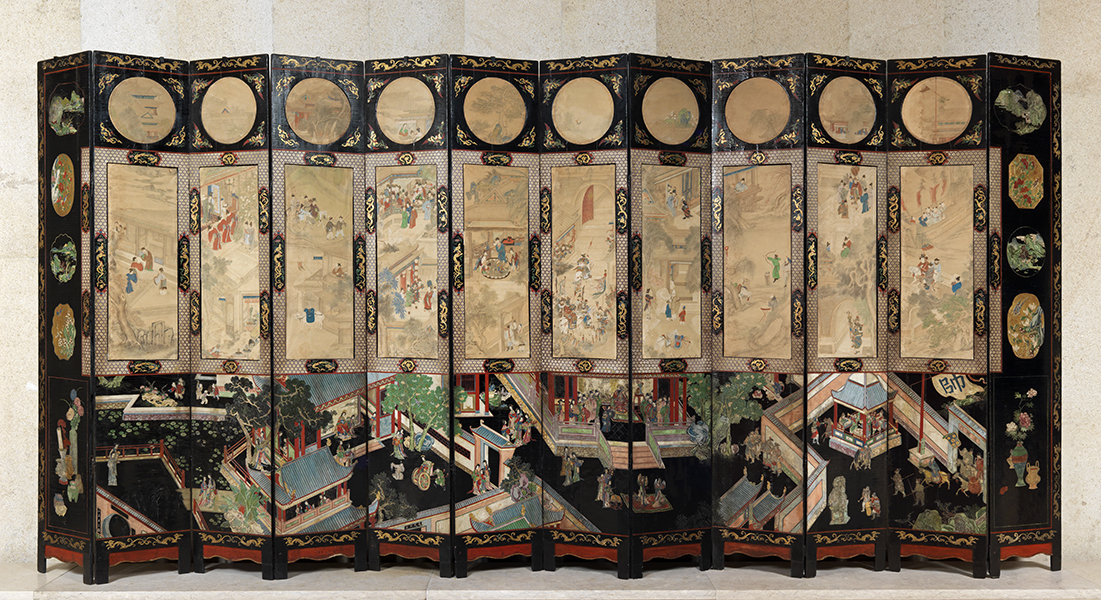
“Paraventi: Folding Screens from the 17th to 21st Centuries” is an extensive exhibition curated by Nicholas Cullinan on view at Fondazione Prada’s Milan venue from 26 October 2023 to 26 February 2024.
The Milan exhibition explores the histories and semantics of these objects by tracing trajectories of cross-pollination between East and West, processes of hybridization between different art forms and functions, collaborative relationships between designers and artists, and the emergence of newly created works. The folding screens embody liminality and the idea of being on the threshold of two conditions, literally and metaphorically. They cross barriers between different disciplines, cultures, and worlds.
As explained by Nicholas Cullinan, “Painting or sculpture? Art or furniture? Utilitarian or ornamental? Decorative, functional, architectural, or theatrical? This innovative exhibition examines the many questions and paradoxes surrounding the unfolding history of the paravent. This history of the folding screen is one of cultural migration (from East to West), hybridization (between both different art forms and functions) and of what is concealed and revealed. As we shall explore, this history, and especially the way it manifests in the present, is one of liminal objects and of liminality itself; in the process collapsing the rigid distinctions and hierarchies between the different disciplines of art and architecture, decoration, and design.”
The exhibition design created for the Podium building by SANAA, the renowned architectural firm founded by Kazuyo Sejima and Ryue Nishizawa, will gather more than seventy folding screens, including valuable historical objects and more recent works on loan from international museums and private collections, and a selection of new creations commissioned from more than fifteen international artists specifically for this project. On the Podium’s ground floor, curved transparent Plexiglas partitions alternating with sinuous curtains will simulate the shapes of these objects. They will create a series of spaces with different light atmospheres, in which visitors will be confronted with each thematic group and connected in continuity in a fluid path, throughout the transparency of the partitions. On the upper floor, the single exhibition space represents the overall history of the screens, which are arranged in chronological order on shaped pedestals, that emphasize the typical paravents shape, in a nod to innovative museological displays such as Lina Bo Bardi’s MASP in São Paulo and indeed SANAA’s work for Louvre-Lens.
On the Podium’s ground floor, an introductory section combines three 17th- and 18th-century Chinese and Japanese screens depicting naval battles and aerial views to investigate these objects’ inherent ambiguity and transnational nature. It focuses on their possible dual reading from an Eastern right-to-left or Western left-to-right perspective, as landscape or cartography. The second sequence explores the theme of representing the seasons and temporal narratives in a spatial dimension by juxtaposing a folding screen by Chinese artist Chen Zhifo, a master of gongbi paintings in the 20th century that meticulously depicted realistic birds and flowers, with a more abstract and ironic one created by American artist Jim Dine in 1969 and titled Landscape Screen (Sky, Sun, Grass, Snow, Rainbow).
With a group of recent and new works by Tony Cokes, Cao Fei, Shuang Li, Joan Jonas, Tiffany Sia, and Wu Tsang, the exhibition also addresses how a seemingly timeless object such as a folding screen can become a medium for projecting a layering of images and multiscreen effects with the pervasive use of digital technologies. Another section delves into one of the functions of the screen, namely to conceal, protect and thus create an intimate, private and secret dimension within the domestic environment. Historical works such as the Three-fold Screen with embroidered panels depicting heroines (The Legend of the Good Women) (c.1860) by William Morris and Elizabeth Burden and Konku (1982) by William N. Copley are associated with contemporary screens by artists such as Lisa Brice, Anthea Hamilton, Lorna Simpson, and Carrie Mae Weems, who through an alternative gaze introduce themes such as seduction and shame.
Queer aesthetics are at the center of another series of works that transform this everyday object into an overtly subversive decoration element. From an Omega workshop screen by Duncan Grant from the Bloomsbury haven of Charleston to a rare 1929 screen made by Francis Bacon and World of Cats (1966) by British actor, writer, and collagist Kenneth Halliwell through to works by contemporary artists such as Kai Althoff, Marc-Camille Chaimowicz and Francesco Vezzoli, a culturally disruptive narrative is told. It should not be forgotten that screens can also be powerful tools of political propaganda, display of strength and wealth, ostentation and construction of narratives capable of affecting history. Examples are the monumental work dating back to 1718 by Pedro de Villegas, consisting of ten elements that feature an account of the Conquest of Mexico by the leader Hernán Cortés on one side, while the back shows a decoration with Eastern scenes, and the new commission given to Goshka Macuga that addresses the theme of the transmission of knowledge and culture.
The last group of works set up on the Podium’s ground floor explores the paradox of transparency through conceptual or humorous negations of the practical function of these objects. The transparent folding screens by Carla Accardi and Isa Genzken frame the surrounding environment rather than concealing it. They open new perspectives and suggest new visions rather than circumscribing a space.
Image : “Coromandel” screen, China, late 18th century Lacquer, oriental wood, paper. 284 x 624 x 2 cm, Calouste Gulbenkian Museum, Lisbon, Portugal © Calouste Gulbenkian Foundation, Lisbon – Calouste Gulbenkian Museum Photo: Carlos Azevedo